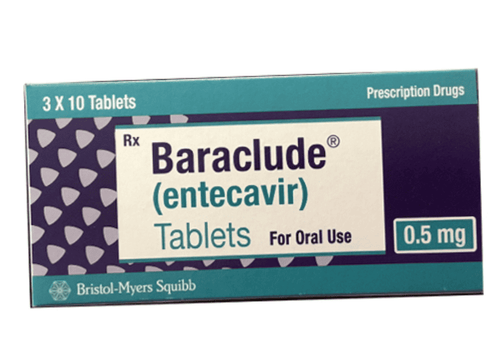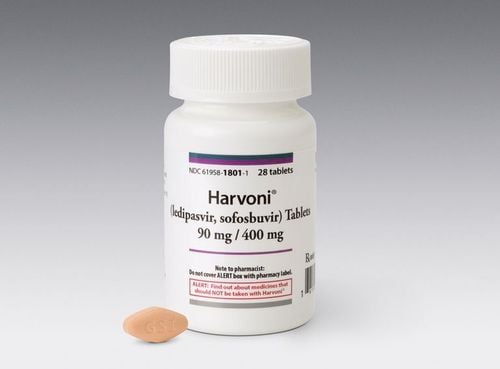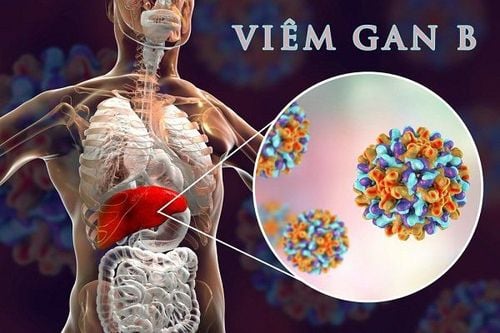This is an automatically translated article.
The article was written by Specialist Doctor II, Senior Doctor Doan Du Dat, Department of Medical Examination and Internal Medicine - Vinmec Ha Long International HospitalHepatitis B is one of the dangerous chronic diseases, causing the death of more than 600,000 people every year worldwide. According to the World Health Organization, there are currently more than 300 million people infected with Hepatitis B worldwide, this number is constantly increasing from 3 to 4 million people every year. Through the following article, we will provide the most general information about this disease.
1. Causes and routes of hepatitis B infection
Hepatitis B is caused by the HBV virus (Hepatitis B Virus). After infecting the body, the virus has an incubation period of 3 to 6 months depending on the condition of each person. Then begins to work and causes acute Hepatitis B. If after 6 months, the patient's body cannot be immune to the virus, the disease will turn into a chronic stage and be infected with HBV for life. The following are some main routes of hepatitis B transmission:First: Mother-to-child transmission: When a pregnant woman is infected with the Hepatitis B virus, the rate of Hepatitis B infection for the fetus is very high, increasing. gradually from pregnancy to birth. In the first 3 months, the infection rate is 10% and the last 3 months increases to 60-70%. The risk of transmitting the disease to the fetus can be up to 90% if there is no timely protective measure immediately after birth. 50% of these children may have chronic Hepatitis B and are at risk of cirrhosis in adulthood.
Second: Sexual transmission: HBV-DNA virus present in the semen of men or in the vaginal secretions of women can infect the partner through small scratches during sexual intercourse. . Therefore, you should not have sex indiscriminately, need to use protection when having sex, do not have oral sex or use unhygienic sex tools.
Third: Blood-borne transmission: Medical incidents such as blood transfusion containing Hepatitis B virus, using medical equipment that is not cleaned, sterilized, containing the virus. Sharing needles, syringes, personal items such as razors, toothbrushes...Using cosmetic services, nailing, tattooing... while tools and machines are used unhygienic and contain disease-causing viruses.

Viêm gan B có thể lây truyền qua đường máu
2. Symptoms to recognize and test methods to diagnose hepatitis B
Hepatitis B is a global disease caused by the hepatitis B virus (HBV). The disease can be transmitted through blood, sex, and from mother to child. If the mother is infected with HBV and has HBeAg (+), the chance of transmitting it to her baby is more than 80% and about 90% of the baby will be born with chronic HBV. Hepatitis B virus can be acute, in which more than 90% of cases are completely cured, nearly 10% turn to chronic hepatitis and the final result is cirrhosis or liver cancer.HBV belongs to the family Hepadnaviridae, has a DNA structure. Based on the sequence of nucleotides, HBV is divided into 10 different genotypes with symbols from A to J. HBV has 3 types of antigens HBsAg, HBeAg and HBcAg, corresponding to these 3 antigens are 3 types of anti- HBs, anti-HBc and anti-HBe. The presence of these antigens and antibodies is important in determining the disease, the disease form as well as the course of the disease. There is now a prophylactic vaccine, which significantly reduces the number of people newly infected with HBV. Hepatitis B often has few obvious manifestations in the early stages with few symptoms, which is easy for patients to be subjective and ignore. Symptoms of Hepatitis B appear more and more pronounced when the disease has progressed for a long time. About 30 to 50% of people infected with Hepatitis B have the following physical symptoms:
Fatigue, lethargy, weakness Anorexia, loss of appetite, fear of grease, digestive disorders, bloating slightly Yellow eyes, yellow skin, dark urine, pale stools Pain in the liver, upper right part of the abdomen Mild fever in the afternoon, itchy sensation on the skin The disease can often manifest as acute or Chronic:
Acute phase:
History of transfusion of blood or blood products, injection, unprotected sex between 4 weeks and 6 months. Clinical: there may be symptoms of anorexia, fatigue, jaundice, less dark urine, pain in the liver, vomiting, nausea, discolored stools... Subclinical:
AST, ALT (liver enzymes) ) is elevated (usually more than 5 times the normal value). Bilirubin is elevated, mainly direct bilirubin. HBsAg (+) or (-) and anti-HBc IgM (+) Chronic stage:
Often subtle clinical symptoms are not obvious, common tests:
HBsAg (+) > 6 months or HBsAg ( +) and Anti-HBc IgG (+). ST, ALT (liver enzymes) increased intermittently or continuously for more than 6 months. Is there evidence of progressive histopathological damage, cirrhosis (determined by liver biopsy or Fibroscan ultrasound) To check for hepatitis B virus infection? It is necessary to carry out the necessary tests and tests to have enough diagnostic data including:
Need to test for HBsAg positive or not? What is the amount of HBsAb?
If HBsAg is positive, then follow the steps below:
1. Test: HBeAg, HBeAb, HBcAb. 2. Liver function test: Check the patient's liver damage. 3. Checking for HBV-DNA: Checking the replication status of the virus in the patient's body. The higher this index, the stronger the virus replication is, and the higher the infectiousness. 4. Ultrasound: Observe the changes of liver, bile, pancreas, this is very beneficial in treatment. Especially need Fibroscan ultrasound to detect cirrhosis early. 5. Liver biopsy: Through biopsied liver cells, you will know the extent of liver damage. HBsAg negative, HBsAb < 100 IU/ml: Vaccination against hepatitis B virus is recommended.

Nên tiêm phòng vắc xin chống vi rút viêm gan B
3. Harms and complications of hepatitis B
After the incubation period, the Hepatitis B Virus begins to become active, attaches to the surface of hepatocytes, relies on the cytoplasm of hepatocytes to copy the genetic code, sprouts from hepatocytes and produces many cells. new cell. This whole process disrupts the functioning of liver cells, increasing the risk of complications.Specific harms of Hepatitis B, including:
Causes liver function decline: The activity of liver cells is destroyed from within the cells, gradually the liver cells will be destroyed, leading to liver damage . At this time, the functions of the liver such as filtering blood, detoxifying, metabolizing chemicals, synthesizing substances... are all impaired.
Causes fatty liver: The activity of breaking down Triglycerides in the liver is reduced, causing fat to not be metabolized but accumulate to cause fatty liver.
Complications Cirrhosis : Hepatitis B if left untreated or ineffectively treated will lead to cirrhosis complications within 20 years or possibly earlier.
Complications Liver cancer: Hepatitis B virus increases the risk of malignant liver cell proliferation during the course of Hepatitis to Cirrhosis. Cancer complications usually occur within 10 years of cirrhosis.
4. Treatment of Hepatitis B
Currently, there is no cure for the HBV virus. Treatment methods only stop at controlling and inhibiting the activity of the virus, returning the virus to an inactive state, preventing the recurrence of the disease and its complications, and helping to restore liver function. Treatment methods for Hepatitis B include:Medication: Using a regimen of drugs Lamivudine, Tenofovir, Entercavir and injectable Interferon to inhibit the activity of the virus, prevent the intracellular reproduction of the virus. The cost of treatment with Interferon is still quite high, but if only treated with other drugs, the patient needs to take the drug for life.
New methods: Techniques such as directional therapy, Ozone reverse infusion, virus isolation are all effective in the treatment of Hepatitis B. New methods with the advantage of limiting side effects, Shorter treatment time and lower cost.
Method of blood transfusion with ozone: Take 100 ml of the patient's blood, then add 100 ml of ozone in a 1:1 ratio so that the ozone molecule can adapt to the blood solution in the body, then inject it into the body. Patients, no side effects, do not affect work and study, the whole process only needs 15-20 minutes.
Method to filter viruses out of blood: Using advanced medical equipment to accurately analyze the hidden virus in the liver, make the virus structure change in the most direct, fastest and most effective way, after That quickly isolates the virus, destroying the virus's genetic wall to avoid the virus's reproduction and replication.
There are also a number of herbal remedies to help treat chronic diseases.

Có thể điều trị viêm gan B bằng thuốc
5. Prevention of Hepatitis B
Proactive prevention:Vaccinate all children with hepatitis B virus within 24 hours of birth and follow-up doses at 2, 3 and 4 months old according to the expanded immunization program. Hepatitis B vaccine is given to people who are not already infected with HBV. HBsAg and anti-HBs should be tested prior to vaccination. To get effective immunity, it is necessary to get 3 injections (2nd dose after 1 month, 3rd dose after 6 months) Hepatitis B vaccine for health workers. Prevention of mother-to-child transmission:
If the pregnant mother has HBsAg (+): Administer hepatitis B virus vaccine after birth to the child according to the expanded immunization program and in combination with anti-HBV antibody injection for the child. Should be injected at the same time but in two different locations. After that, give the child a full dose of hepatitis B vaccine according to the provisions of the expanded immunization program. If pregnant mother has HBV-DNA > 106 copies/ml (200,000 IU/mL): Take antiretroviral drugs (lamivudine or tenofovir) from 3rd trimester of pregnancy. Re-test for HBV DNA 3 months after delivery to decide whether to discontinue the drug or continue treatment if the mother is eligible for treatment. Closely monitor the mother for hepatitis flare-ups. Non-specific prevention:
Screening of blood and blood products. Do not share needles and other skin-piercing devices. Safe sex. Avoid contact with blood and secretions of patients infected with HBV. Take standard precautions similar to those of blood-borne diseases. Customers who want to have a health check-up, medical examination or vaccination at Vinmec Ha Long International General Hospital, please contact via phone number: 02033.828.188. Press 0 to schedule a specialist examination, press 2 to contact vaccination. Medical staff are ready to serve you.
Address : Vinmec Ha Long International General Hospital, 10A Le Thanh Tong, Hong Gai, Ha Long, Hong Gai, Ha Long. Register online HERE













